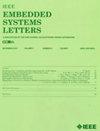Simplified Oblique Decision Tree Accelerator
IF 2
4区 计算机科学
Q3 COMPUTER SCIENCE, HARDWARE & ARCHITECTURE
引用次数: 0
Abstract
In recent years, hardware platforms like field programmable gate arrays (FPGAs) and application specific integrated circuits (ASICs) are highly preferred for implementing machine learning algorithms in low-power or high-speed applications. This letter proposes a simplified oblique node decision tree algorithm. The classification is implemented on FPGA and ASIC for activity recognition and Parkinson’s tremor detection. A mode number is used to choose the application mode. To provide better classification performance, efficient multiplier-less architectures have been used for power efficiency. This design operates at a maximum frequency of 167 MHz and has the lowest latency as compared to the existing hardware. It is also found to have very low resource consumption as compared to other existing high-speed architectures.简化倾斜决策树加速器
近年来,现场可编程门阵列(fpga)和专用集成电路(asic)等硬件平台非常适合在低功耗或高速应用中实现机器学习算法。本文提出了一种简化的斜节点决策树算法。在FPGA和ASIC上实现分类,用于活动识别和帕金森震颤检测。模式号用于选择应用模式。为了提供更好的分类性能,已经使用了高效的无乘数架构来提高功率效率。与现有硬件相比,该设计在167 MHz的最大频率下工作,并且具有最低的延迟。与其他现有的高速架构相比,它的资源消耗也非常低。
本文章由计算机程序翻译,如有差异,请以英文原文为准。
求助全文
约1分钟内获得全文
求助全文
来源期刊

IEEE Embedded Systems Letters
Engineering-Control and Systems Engineering
CiteScore
3.30
自引率
0.00%
发文量
65
期刊介绍:
The IEEE Embedded Systems Letters (ESL), provides a forum for rapid dissemination of latest technical advances in embedded systems and related areas in embedded software. The emphasis is on models, methods, and tools that ensure secure, correct, efficient and robust design of embedded systems and their applications.
 求助内容:
求助内容: 应助结果提醒方式:
应助结果提醒方式:


